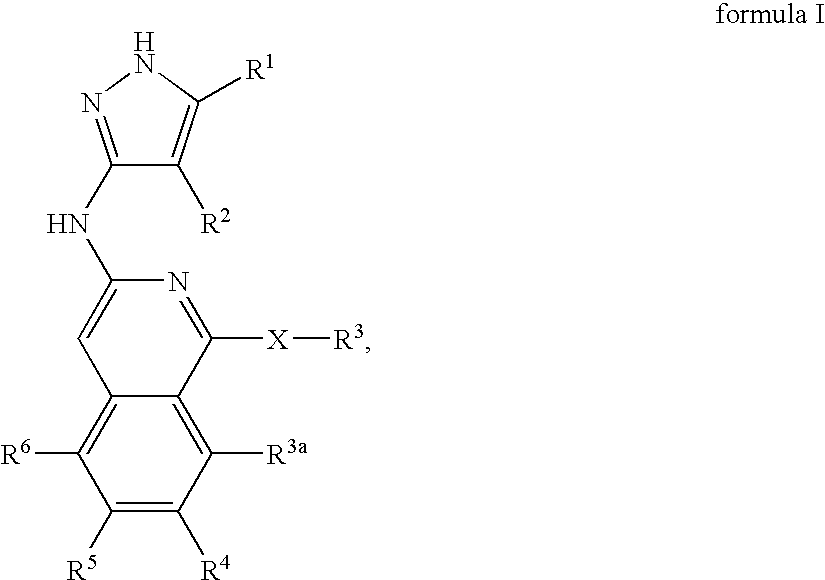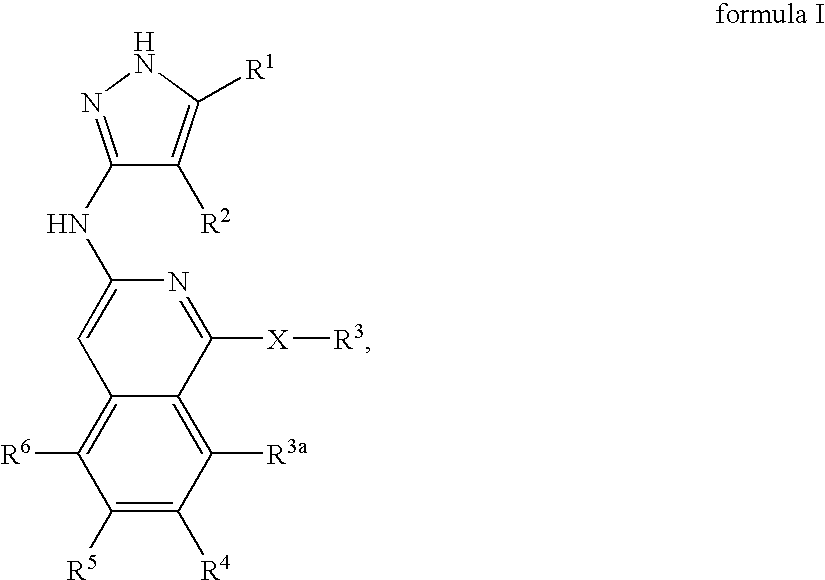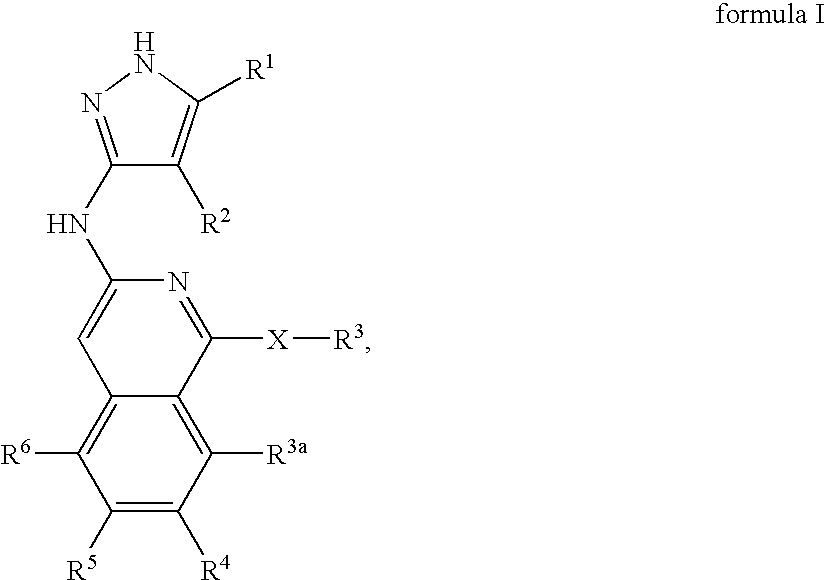Isoquinoline aminopyrazole derivatives
- Summary
- Abstract
- Description
- Claims
- Application Information
AI Technical Summary
Benefits of technology
Problems solved by technology
Method used
Image
Examples
example 1
[0893] (1-Chloro-isoquinolin-3-yl)-(5-methyl-1H-pyrazol-3-yl)-amine
a) Preparation of indan-1,2-dione-2-oxime
[0894]
[0895] To a solution of 1-indanone (19.5 g, 0.15 mol) in 200 ml of ether was added 15 ml of concentrated HCl, then a solution of n-butylnitrite (18.75 ml, 0.16 mol) in 50 ml of ether at room temperature. The resulting mixture was stirred for 2 h, the precipitate was collected and dried to yield a white solid (15.4 g, 65% yield). LC-MS: 162 (MH+)
b) Preparation of 2-cyanomethyl-benzoic acid
[0896]
[0897] Indan-1,2-dione-2-oxime (35 g, 0.22 mol) was added to a solution of 402.5 ml 8% NaOH, and the mixture was heated to 500 C. Then p-toluenesulfonyl chloride (54.25, 0.28 mol) was added in portions to the mixture, and the mixture was heated at 800 C for 15 min. After cooled to room temperature, the precipitate was removed from the mixture. The filtrate was acidified with concentrated HCl to pH=3-4 and the precipitate was collected and dried to give colorless solid (26 g, 7...
example 2
[0902] (1-Chloro-6-methoxy-isoquinolin-3-yl)-(5-methyl-1H-pyrazol-3-yl)-amine
a) Preparation of 5-methoxy-indan-1,2-dione-2-oxime
[0903]
[0904] To a solution of 5-methoxy-1-indanone (25 g, 0.15 mol) in 300 ml MeOH was added 15 ml concentrated HCl, and then n-butylnitrite (19.5 ml, 0.17 mol) in 50 ml MeOH at 400 C. The solution was stirred for 2 hours during which time a precipitate was formed. The precipitate was collected and dried to yield a white solid (22.3 g, 75% yield). LC-MS: 192 (MH+)
b) Preparation of 2-Cyanomethyl-4-methoxy-benzoic acid
[0905]
[0906] 5-Methoxy-indan-1,2-dione-2-oxime (22 g, 0.12 mol) was added to a solution of 230 ml 8% NaOH. The mixture was heated to 500 C, and then p-toluenesulfonyl chloride (30 g, 0.16 mol) was added in portions. The mixture was heated at 800 C. for 15 min. After cooled to room temperature, the precipitate was removed, and the filtrate was acidified with concentrated HCl to pH=3-4. The precipitate was collected and dried to give colorles...
example 3
[0911] (1-Chloro-isoquinolin-3-yl)-(1H-pyrazol-3-yl)-amine
a) Preparation of 3-(1H-pyrazol-3-ylamino)-2H-isoquinolin-1-one
[0912]
[0913] 2-Cyanomethyl-benzoic acid (1.61 g, 0.01 mol), 3-amino-pyrazole (1 g, 0.01 mol), acetic acid (15 ml), were sealed in a bottle (20 ml). The mixture was heated at 1300 C for 20 minutes under microwave irradiation. The mixture was concentrated and the residue was dissolved in 5 ml MeOH. The solution was added dropwise to 200 ml water. After stirred for 1 hour, solid was collected and dried to give product (1.8 g, 75% yield). LC-MS: 227 (MH+)
b) Preparation of (1-chloro-isoquinolin-3-yl)-(1H-pyrazol-3-yl)-amine
[0914]
[0915] 3-(1H-Pyrazol-3-ylamino)-2H-isoquinolin-1-one (7.4 g, 0.03 mol) and POCl3 (80 ml) were sealed in 4 different bottles (20 ml). The mixture was heated at 1300 C for 15 minutes under microwave irradiation. The mixture was concentrated, the residue was treated with 15 ml MeOH and stirred for 2 hours at room temperature. The solid was co...
PUM
| Property | Measurement | Unit |
|---|---|---|
| Molar density | aaaaa | aaaaa |
| Molar density | aaaaa | aaaaa |
| Molar density | aaaaa | aaaaa |
Abstract
Description
Claims
Application Information
 Login to View More
Login to View More - R&D
- Intellectual Property
- Life Sciences
- Materials
- Tech Scout
- Unparalleled Data Quality
- Higher Quality Content
- 60% Fewer Hallucinations
Browse by: Latest US Patents, China's latest patents, Technical Efficacy Thesaurus, Application Domain, Technology Topic, Popular Technical Reports.
© 2025 PatSnap. All rights reserved.Legal|Privacy policy|Modern Slavery Act Transparency Statement|Sitemap|About US| Contact US: help@patsnap.com



